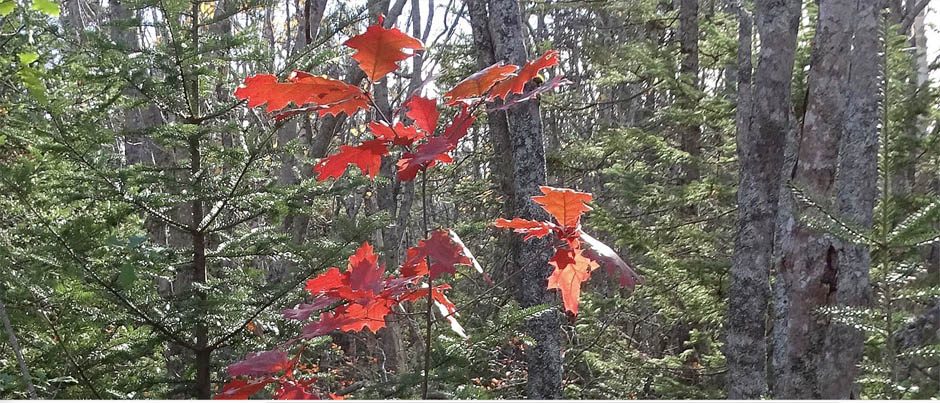Navigation: This page is a subpage of Wabanaki Forest, a top level page on the website Nova Scotia Forest Matters (nsforestmatters.ca)
Received by NSFN, From: unamakimedicinecamp
Mon, Sep 15, 2025
Subject: FOR IMMEDIATE RELEASE: Mi’kmaq Establish Cultural Revitalization Camp at Hunters Mountain in Unama’ki
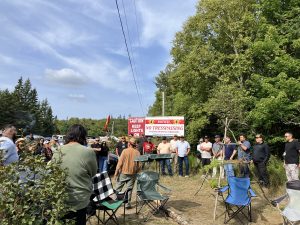
Photo by NN during visit to Hunters Mountain Mi’kmaw protest on Sep 9, 2025 to take supplies and donations from SOOF. View related social media post
Unama’ki – More than 100 Mi’kmaw rights holders have established a cultural revitalization camp at the foot of Hunters Mountain in Cape Breton, transforming what began as a logging blockade into a centre for traditional medicine gathering and cultural teachings.
“We’re not only asserting our rights,” says Allison Bernard, of Eskasoni First Nation. “We’re reclaiming our culture and traditions. This mountain is a part of us. Our ancestors are here. Our relatives the moose are here.”
It comes amid frustration about ongoing logging operations on Hunters Mountain without adequate consultation with the Mi’kmaq, despite being Crown land on the unceded territory of Mi’kma’ki.
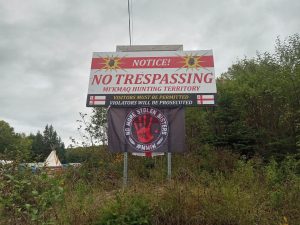
Photo by Rene Doucet Cottreau; view related post
Elder Ernie Johnson, who is providing teachings at the camp, explains the significance of the mountain: “Balsam is held very sacred to our people. It’s a medicine, and it’s being used for something else. We need to bring this mountain back to its original intent for the wellbeing of our people.”
The contrast between government and Mi’kmaw understanding of the land lies at the heart of the conflict. While government and private companies view forests as economic resources, for the Mi’kmaq, these lands are sacred and provide food, medicines, and habitats for relatives like the moose.
The camp has received formal support from Mi’kmaw organizations. The Maw-lukutijik Saqmaq (Assembly) has called for a wholistic plan “that incorporates Mi’kmaw laws around appropriate land and resource use, Mi’kmaw laws that emphasize the importance of stewardship and sustainability for the next seven generations.”
 Sipekne’katik First Nation has also voiced strong support, stating: “Closing the area to Mi’kmaw harvesters while allowing industrial activity like logging undermines our Treaty rights and our stewardship responsibilities.”
Sipekne’katik First Nation has also voiced strong support, stating: “Closing the area to Mi’kmaw harvesters while allowing industrial activity like logging undermines our Treaty rights and our stewardship responsibilities.”
Camp organizers are calling on all Nova Scotians to voice their concerns about Crown land forests being mismanaged by successive governments and private corporations.
“Corporate profits are being made off the backs of our Mi’kmaw rights. This needs to stop,” says Alexina Doucette, a camp member from Eskasoni First Nation. “All Nova Scotians should be concerned that the same forestry companies that are logging our forests are the ones being paid by the government to so-called manage them. You don’t need a degree in forestry to see that our forests are sick and that this system is broken.”
The Mi’kmaw rights holders at the camp emphasize that their actions are about protecting the land for future generations. “We’re running out of time to save our forests, our medicines, the moose,” says Allison Bernard. “We need everyone to care and to respect Mi’kmaw rights. We Are All Treaty People.”
The camp welcomes visitors who wish to learn about Mi’kmaq culture and traditional ecological knowledge, and invites all Nova Scotians to stand in solidarity with their efforts to protect the land for future generations.
———–
FROM NSFM
We are told that Letters of support in hard copy should be sent to Cheryl Maloney,
PO Box 54, Shubenecadie NS B0N 2H0
Hunters Mountain Protest: Some Related News, Social Media Posts
Most recent at top.
Oct 22, 2025:
– N.S. still failing to consult on law blocking protests on Crown land: Mi’kmaq leaders
By The Canadian Press on CTV News “HALIFAX — A Mi’kmaq leader in Nova Scotia says the provincial government continues to ignore First Nations’ concerns on a new law they say targets their community’s ability to protect its territory. The law was recently pushed through the legislature without advanced notice or consultation, said Twila Gaudet, the director of consultation for Kwilmu’kw Maw-klusuaqn, which works on behalf of the Assembly of Nova Scotia Mi’kmaw Chiefs. In a statement Tuesday, Gaudet said the law “appears to be targeting Mi’kmaw harvesters who are protesting the unsustainable forest management practices in the Cape Breton Highlands.” Among other things, the law makes it illegal for protesters to block forest access roads on Crown land, and offenders could be fined up to $50,000 and imprisoned for up to six months. It also allows government to “demolish or otherwise dispose of” structures on Crown land if they pose a threat to the province’s economic interests…Minister of L’nu Affairs Leah Martin said she is having regular conversations with the assembly and other chiefs, but she notes that the law does not legally require formal consultation with Mi’kmaq leaders…On Oct. 3, the day the bill received royal assent, Sipekne’katik First Nation put out a statement calling for Martin’s resignation. “Minister Martin does not speak for Sipekne’katik, and she most certainly does not speak for the Mi’kmaq Nation,” Chief Michelle Glasgow said on the passing of the bill.”
Oct 12, 2025:
– First Nations have moral authority for nature, Membertou convention hears
Rosemary Godin for Saltwire ““But what the elders were telling me was that our people and our responsibility is to care for the land and the resources as our first priority.” – Senator Dan Christmas”…Indigenous people have a responsibility to nature, Sen. Dan Christmas said last week as a special conservation gathering held at Membertou First Nation welcomed Indigenous knowledge keepers and land protectors from British Columbia to Canada’s North to Hunters Mountain in Nova Scotia. “We (Indigenous people) have a moral authority to do sustainable development,” Christmas said. “And it is not up to any outside government. It falls on our shoulders. We have that responsibility.Hosted by the national Assembly of First Nations, Membertou First Nation in Cape Breton was chosen as the site for hundreds of delegates. The gathering was called “Upholding our Relationship to Mother Earth and Stewarding for Abundance.” The event was opened and closed by Christmas who said that one of the messages he heard throughout the conference was that the Indigenous have been gifted by the Creator to fulfill the responsibility to care for the land, the water and the air. “And it’s not just for us — the Indigenous people. That gift was given as a responsibility for us to help all people, all of humanity on the earth — so that’s a beautiful gift.” ”
Oct 3, 2025:
– Chiefs Angered at Premier Houston’s Speed of Business & Lack of Respect
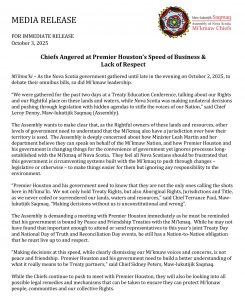
Post on Assembly of Nova Scotia Mi’kmaw Chiefs public FB page, full text also copied onto this website here.
Media Release from the Assembly of Nova Scotia Mi’kmaw Chiefs “…The Assembly wants to make clear that, as the Rightful owners of these lands and resources, other levels of government need to understand that the Mi’kmaq also have a jurisdiction over how their territory is used. The Assembly is deeply concerned about how Minister Leah Martin and her department believe they can speak on behalf of the Mi’kmaw Nation, and how Premier Houston and his government is changing things for the convenience of government yet ignores processes long- established with the Mi’kmaq of Nova Scotia. They feel all Nova Scotians should be frustrated that this government is circumventing systems built with the Mi’kmaq to push through changes – legislative or otherwise – to make things easier for them but ignoring any responsibility to the environment…”
– Mi’kmaw chiefs accuse N.S. premier of dismissing concerns in short fall session
CBC News “The Assembly of Nova Scotia Mi’kmaw Chiefs is demanding a meeting with Premier Tim Houston after a short fall sitting of the legislature during which they say the voices of their communities were stifled. The fall session at Province House, which wrapped up Friday after eight days, was dominated by a contentious omnibus bill that would make it illegal to block forest access roads on Crown land. Bill 127 was passed late Thursday. The chiefs have said they did not know the changes were in the works. “Making decisions at this speed, while clearly dismissing our Mi’kmaw voices and concerns, is not peace and friendship,” Chief Sidney Peters said in a news release issued by the assembly, referring to the Peace and Friendship treaties that were first signed by the Crown and the Mi’kmaq 300 years ago…”
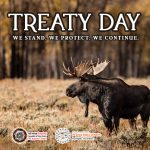 Oct 1, 2025:
Oct 1, 2025:
– The Assembly of Nova Scotia Mi’kmaw Chiefs
Today, we honour our Treaties, the strength of our people, and the path we continue to build — for the generations yet to come
– Mi’kmaw land protectors say they won’t leave mountain even if Nova Scotia passes controversial law
By Angel Moore for APTN News “While the Nova Scotia government works to pass its controversial law that would make it illegal to block forest roads in the province, Mi’kmaw land protectors say they’re not going anywhere.”
Sep 26, 2025:
– Cape Breton moose harvesting moratorium extended for another year as population rebounds
By Sean Mott for CTV News “The Assembly of Nova Scotia Mi’kmaw Chiefs says it is extending its moratorium on moose harvesting in Cape Breton for another year as the population shows signs of rebounding. In July 2024, the Nova Scotia government implemented a three-year suspension of the licensed moose hunt in Cape Breton over concerns with dwindling population numbers. At the time the number of moose had dropped from 1,500 to roughly 835. The Assembly also put a moratorium on their rights-based moose harvest until the population reached a sustainable number…According to the newsletter, the 2025 aerial survey of the five moose management zones in Cape Breton showed the population now sits at an estimated 1,900 moose. Ten years ago there were more than 4,700 moose in the region. The survey also found there were more calves and bulls in the population, and more moose were seen in areas farther south. The Assembly says there needs to be between 3,000 and 3,600 moose for there to be a sustainable harvest.”
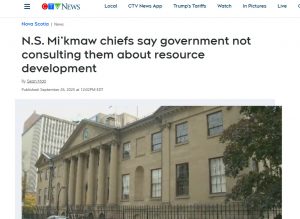 – The Assembly of Nova Scotia Mi’kmaw Chiefs
– The Assembly of Nova Scotia Mi’kmaw Chiefs
Sep 26, 2025
We provided comment to the media today about bills being passed by Nova Scotia. You can find this article on CTV’s website and read the full statement we issued to media here:
“Despite repeated assurances, the provincial government continues to make significant legislative and policy announcements on natural resource development, without advance notice to, or discussion with, the Mi’kmaq. Several of the recent legislative amendments seem to target protest activity on Crown lands, at a time when there are active community concerns about what is happening on Hunter’s Mountain. This should be a time for greater trust-building with the Mi’kmaq, not escalating tensions and aggressive enforcement action. The amendments geared towards cutting red tape for mineral development caters to industry and appears to ignore our concerns and recommendations made to the Legislative Standing Committee in May. These measures only risks eroding Consultation and shortens timeframes available for discussions to take place in good faith with the Mi’kmaq” – Maw-lukutijik Saqmaq.
Sep 23, 2025:
– Omnibus bill tackles Crown land protesters in N.S., supports domestic violence survivors
Michael Gorman · CBC News “Provisions around the training for bouncers, support for survivors of gender-based violence and new powers to deal with protesters blocking logging roads on Crown land might not seem to have much in common, but the Nova Scotia government is dealing with those issues and more in a piece of legislation introduced Tuesday at Province House. The Protecting Nova Scotians Act is omnibus legislation the government tabled on the first day MLAs returned to the legislature for the fall sitting…”
“Notable changes included in the bill include amendments to the Crown Lands Act that will make it illegal to “block, obstruct the use of or impede access to” forest access roads. It will also give officials the ability to remove structures without notice when they’re deemed to be a hazard to public health and safety or are harmful to the economic interests of the province. The rules now require 60 days’ notice before a structure can be removed. An official with the Natural Resources Department said the changes are being made out of concern for people who might be set up too close to logging equipment and also to expand the definition of what constitutes blocking a road. The proposed changes come as protesters in Cape Breton are blocking a logging operation by Port Hawkesbury Paper on Crown land, citing concerns about the cut’s impact on wildlife habitat and the health of the forest.“
Sep 22, 2025:
– Retired wildlife biologist on impact of clear-cutting in Cape Breton Highlands
Bob Bancroft in the Halifax Examiner “Regarding Port Hawkesbury Paper (PHP) pulp mill operations on the Cape Breton Highlands: “They’ve exhausted the carrying capacity of the land with their rate of extraction. Clear-cutting is a dangerous process. They say they are doing reforestation when they replant but when they are just planting conifers they are changing the genetics of the forest and ultimately that has an effect on the biodiversity of the area,” Albert Marshall told the Chronicle Herald on Sept. 6, 2025 Indigenous Elder Albert Marshall is absolutely correct. As a biologist, I affirm his assertions with additional points for consideration. I was a provincial regional biologist for the eastern mainland in the 1970’s and ‘80’s…Taxpayers are paying $5 million a year to PHP for forestry operations that severely degrade the sites, creating wildlife wastelands instead of ecologically-diverse, naturally fire-resistant habitats on public lands. Thank you for speaking up, Albert Marshall.”
Sep 17, 2025:
– Mi’kmaw land protector hopes that sharing his son’s story will help protect Hunter’s Mountain
By Nangoonskeh Rose Jacobs “Frederick Sylliboy stands at the edge of the forest on Hunter’s Mountain in Unama’ki, also known as Cape Breton Island in Nova Scotia, holding memorial plaque engraved with the face of his late son, Kris. In the forest behind him once stood a sacred tree marking where Kris shot his first moose in 2000. His son died in 2008 of cancer. The plaque was nailed to the tree to honour Kris’s memory. Five years ago, Sylliboy said he received a phone call from a friend alerting him that the tree had been cut down. He described his reaction when he received the news…Sylliboy is one of the people guarding a checkpoint on Hunter’s Mountain in an effort to prevent clear cutting and protect the forest. It began two weeks ago after rising concerns from Mi’kmaq communities over the harmful impact’s clearcutting pose to the moose population, sacred sites and medicines of the land…Amy Maloney of Sipekne’katik First Nation is at the camp to help protect the forest, she also picks medicines like wild white sage and cedar. She described the overwhelming feeling of “real Indigenous pride” after taking part in a drum circle singing the honor song with other land protectors and supporters on the mountain. “We decide together as a team on how we’re going to steward this land together and how we’re going to keep our resources going because that’s the most important thing for us and if you’re not going to work with us, then you’re not going to work at all” Maloney said.” Note: The article provides a summary of the issues, history of the protest to date.
Sep 16, 2025
– Mi’kmaq Media Team Detained by RCMP
Post on Micmac Association Rights website, “On September 13th, 2025 the MRA Media Team was out on assignment, documenting the devastation of unceded Mi’kmaw lands on Hunter’s Mountain. The team was being surveilled by a helicopter they later identified as an Airbus H125, a common civilian helicopter but also used by the Nova Scotia RCMP as requested from the federal branch. Shortly after filming, RCMP Liaison Holly Murphy unlawfully detained the MRA Media Team…Canadian law states that anyone, journalist or otherwise, may film where they have “right of access”. As Mi’kmaq People documenting damage to their traditional hunting grounds it would be reasonable to state that the MRA Media Team has “right of access”.”
– The Cape Breton Highlands moose, the Mi’kmaq blockade and the return of spruce budworm
By Aaron Beswick for Saltwire “…For the past three centuries, Highlands moose have repeatedly boomed and crashed, following cycles of the boreal forest…The budworm may be a worse threat now to the wild areas of the Highlands due to climate change and the arrival of other species. But would preventing an outbreak, along with the severe wildfires that might follow, not also be interfering in a natural process some species have long relied upon? Even if we try to stop the spruce budworm, can we? If not, what devastation is looming for the highlands?…The Mi’kmaq continue their blockade. Organizers issued a release Monday declaring that the camp at the entrance to Hunters Mountain Road was now a centre for traditional medicine gathering and cultural teachings. “The contrast between government and Mi’kmaw understanding of the land lies at the heart of the conflict,” reads the release. “While government and private companies view forests as economic resources, for the Mi’kmaq these lands are sacred and provide food, medicines, and habitats for relatives like the moose.” Meanwhile, the spruce budworms detected around the Highlands’ borders are wrapped up in their silken homes built in the crevasses of bark and bud. They’re molting, growing and waiting for spring.”
Sep 14, 2025
– I had the privilege this weekend to visit the Mi’Kmaw Land Defenders on Hunters Mountain in Unama’ki.
Rene Doucet Cottreau on Friends of Goldsmith Lake FB page, Sep 14, 2025
Sep 12, 2025:
– Paper company suspends logging in Cape Breton Highlands amid Mi’kmaw blockade
Sis’moqon for CBC News, “Assembly of Nova Scotia Mi’kmaw Chiefs says it’s in talks with province, Port Hawkesbury Paper”
– SOOF takes donations and supplies to the Hunters Mountain Mi’kmaw protest
Nina Newington on Friends of Goldsmith Lake FB page
Sep 9, 2025:
– Mi’kmaq continue blockade of forestry in Cape Breton Highlands
By Aaron Beswick for Chronicle Herald, ““They’re clear-cutting our land and we’re trying to save it,” said Madonna Bernard, who also goes by her Mi’kmaq name, Kuku’wes, as she stood in front of the logging truck.“This is not a protest, this is a protection. We’re willing to stay as long as it takes…The Department of Natural Resources has not responded to multiple Chronicle Herald requests regarding the blockade and moose populations since the protest began…On Monday morning, Port Hawkesbury Paper mill manager Bevan Lock said the company has multiple forestry agreements with First Nations in Cape Breton and that it manages the lands sustainably.It also has Sustainable Forestry Initiative certification. “These standards ensure that the company meets all requirements for the management of ecological, social and economic forest values,” reads the mill’s 2023 sustainability report.”
Sep 4, 2025:
– Mi’kmaq block Hunters Mountain in protest of forestry’s impact on moose
By Aaron Beswick for Saltwire “A Mi’kmaq-led protest is blocking access for forestry companies to Hunters Mountain in Cape Breton. Organizer Ashton Bernard told The Chronicle Herald on Thursday it is to force the provincial government to meet with the Mi’kmaq about joint management. The protest comes as rumours circulate that there once again will not be a moose hunt for Mi’kmaq or non-aboriginal hunters.“This is not about wanting to hunt moose, we know they are in danger and we can’t do that,” said Bernard.“This is about them raping the land and destroying the habitat…Elder Albert Marshall said that harvesting softwood trees and replanting spruce and fir was limiting biodiversity and hurting species such as moose. “They’ve exhausted the carrying capacity of the land with their rate of extraction,” said Marshall, who is from Eskasoni. “Clearcutting is a dangerous process. They say they are doing reforestation when they replant but when they’re just planting conifers they are changing the genetics of the forest and ultimately that has an effect on the biodiversity of the area…“We are supposed to be co-managers of these lands, waters and resources, yet decisions continue to be made that are impacting our position and our rights,” said Chief Tamara Young, co-lead of environment, energy and mines for the assembly, in a written statement. “Our concerns are often overlooked and dismissed, and it is clear that community members are frustrated with the position that puts us in as a nation.” The Assembly of Nova Scotia Mi’kmaw Chiefs is supporting the protest. COMMENT: I am told that Hunter Mountain is the main road that is the access for all of the CB highlands that Port Hawkesbury Paper is on. From the article: “The Cape Breton Highlands, along with other Crown land throughout Cape Breton and in Antigonish and Guysborough counties, is managed by Port Hawkesbury Paper. Under the forest utilization and licensing agreement renewed in 2023, the province pays the company $5 million annually to manage the land. The renewed agreement, which runs until 2043, allows Port Hawkesbury Paper to harvest 275,000 “green” tonnes annually off some 520,000 hectares. The original agreement, signed in 2012 by Darrell Dexter’s NDP government, allowed the mill to harvest 400,000 tonnes annually.”
– Clear cutting has gone too far in Hunters Mountain: activists
CBC News Video. “On Thursday, a group of Mi’kmaw activists in Cape Breton stopped trucks from taking wood from the area. Anna Rak has the story.”
